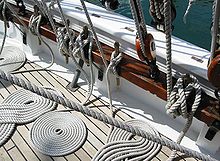cordage

Rope is in the Seemannssprache the generic term for all beaten and braided ropes from nature - and synthetic fibers . A particular group of the sails or hurt is the Hercules rope comprising a core having (core) wire rope.
construction
Rigid rope
The structure of the laid cordage is based on the twisting of strands that are alternately turned left and right under tension. Thus, with the most common ropes, three cardeles are twisted to the right, which in turn are composed of a large number of yarns to the left . The yarns are again composed of individual threads in a clockwise direction, which in turn are composed of individual fibers twisted to the left .
Overview
- Fiber = basic element of a thread
- Thread = composed of several twisted fibers
- Yarn = composed of several oppositely twisted threads
- Kardeel = composed of several oppositely twisted yarns
- Rope = composed of several oppositely twisted cardeles
- Tross = composed of several oppositely twisted ropes
Braided cordage
There are three types of braided rope:
- as a square braid (Squareline): Eight cardels are braided together. Half of these are turned to the left or right, so that an approximately square rope cross-section results. This type of braiding has the advantage that the resulting rope is very elastic and manageable.
- as a hollow braid: This line consists only of load-bearing fibers and is therefore very light and easy to splice .
- as a core-sheath braid: The load-bearing part of the line is surrounded by a sheath that protects the core from abrasion and weathering.
Dyneema hollow braid
Use of the terms "rope" and "rope"
The term Tau is nautical in use only as part of word, as Geitau to Aufgeien a Rahsegels . For example, the term “line” or “end” is used for a single “rope”. The term cordage is a generic term and is used for the material itself. Ropes do not refer to a specific object (not: "Please give me the rope over there.", But rather "Please give me the rope over there." But: "He's dealing with ropes.").
Types of ropes used in seafaring
Terms still in common use today are shown in bold . Terms that are unusual or even frowned upon in seafaring such as "ribbon", "cord", "cord" and the like. are not listed here.
- Yarn : thin Lanyard for sewing or Taklinge (so-called. Takelgarn ) or for general protection works ( "Festbändseln")
- Schiemanns yarn : thin (approx. 4 mm), tarred natural fiber cordage
- Lanyard : thin rope for general fastening work, slightly thicker than thread (typically about 2–6 mm in diameter).
- Zeiser or Zeising : short ropes, sometimes made of webbing, for various purposes such as lashing sails or equipment
- Line : a general term for rope of medium diameter (typically about 6–20 mm in diameter). The word linen refers to the original material, the flax fiber of the linen .
- Horse leash: strong leash made of hemp
- Hawser : heavy line with a large diameter, for example for mooring large ships
See also
Web links
- About rope in general ; from: 'Practical textbook for young seafarers ...', Danzig 1872 (Google Books) p. 1 ff.
Individual evidence
- ↑ List of common marine expressions and their meanings. Retrieved July 25, 2018 .




